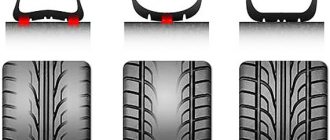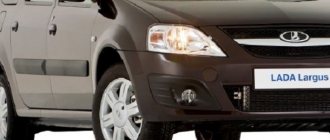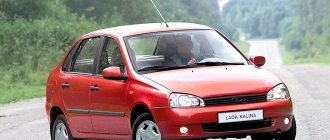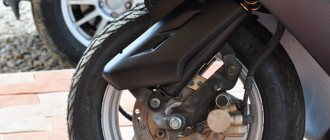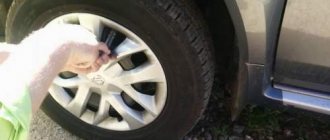The start of sales of the Lada Vesta SV Cross all-terrain station wagon was given about a year ago. The new product of the domestic automobile industry turned out to be quite successful in sales. This is facilitated by a fresh design and good build quality. In addition to this station wagon, the AvtoVAZ line, as you've probably heard about, includes the Vesta sedan models (regular and cross versions) and the Vesta SV city station wagon. A characteristic difference between the SV Cross station wagon and other models is the installation of large wheels with a diameter of 17 inches. In this article, we suggest delving into the topic of wheels and answering basic questions about choosing tires for the Lada Vesta SV Cross.
Experienced car owners know that tires are an important component in the operation of the car. The choice of tires affects many parameters, including handling, braking distance, fuel consumption, vehicle acceleration dynamics and road stability. In addition, well-selected tires reduce driving noise and reduce the wear and tear of your vehicle's suspension. As you can see, the choice of car tires for the Lada Vesta SV Cross, as well as for any other car, must be approached very responsibly.
How often to measure to kill rubber
Please note that pressure may change due to changes in ambient temperature.
Moreover, the process occurs equally in winter and summer. The main rule when checking is to measure it before driving, before the tires get hot. After a short trip, the wheels become very hot and the performance differs significantly from the real ones. Measurements should be taken not only after tire wear has become noticeable. The manufacturer recommends checking the inflation when you feel that the car is behaving differently.
For example, it began to throw to the sides, uncertainly when entering turns. In any operating book you will find information that a check must be carried out if temperature changes reach 10-15 degrees.
As a rule, these are the spring/autumn seasons, be careful this is a time of temperature fluctuations.
In what units is tire inflation measured?
The difference in the degree of tire inflation depends on the basic parameters of the car:
- Gross vehicle weight with or without loading. With a loaded car, the wheels are pushed through more than with an empty trunk and driver.
- Cylinder dimensions. Tire cavity capacity is of primary importance. For example, the pressure in winter tires R13 VAZ 2106 and R 16 on Vesta will differ by an average of 0.4 BAR.
- Speed index. At high speeds and driving on smooth asphalt, an improved free run is required. At the same time, for off-road modifications – this is not necessary.
In the CIS countries, the most common technical atmospheres are At, and pascals (kPa) or the metric system. However, in Europe and the USA, the units of measurement are their own (PSI, BAR). Due to the widespread use of imported rubber in Russia, the buyer needs to know exactly the ratio and compatibility of pressure gauge designations:
- 1 kg/cm²=98 kPa;
- 1 BAR= 100kPa;
- 1PSI= 6.9 kPa.
Low profile tire pressure
This parameter, ignored by novice car enthusiasts, is very important when operating cars with any tires, and especially with low-profile ones. The required tire pressure is always indicated by the vehicle manufacturer in the operating instructions and in an accessible place on the body, for the Lada Vesta - on the B pillar on the driver's side.
- Low profile tires require increased attention to pressure, as insufficient pressure will make the wheels and suspension even more vulnerable to potholes and rocks on the road.
- As many years of experience have shown, the pressure in low-profile tires must be maintained 15% higher than that specified by the manufacturer for wheels of the recommended size.
Decoding tire markings
However, not everyone finds it easy to understand the large number of parameters with which tires are marked.
As a rule, when choosing tires, buyers focus only on the diameter, width of the rubber profile and height, after which the speed and load capacity index are selected.
Now let’s look at what this or that inscription on car tires means. Let's do this using the example of a tire marked 195/65 R15 91 T XL. In this case, the manufacturer and the specific model are not important, we are only interested in the marking itself.
The first number in the marking always indicates the width of the tire in millimeters. The sample in question has a diameter of 195 mm.
The next number is the tire height. 65 is the percentage of height to width. With simple steps we get approximately 127 mm (65% of 195).
Next comes the English letter R. Contrary to the opinions of many car owners, it does not mean the size, that is, the radius, of the tire, but denotes the tire manufacturing technology. R - radial cord. All types of tires for cars are produced using this technology.
To be fair, it is worth noting one more meaning of the designation of the letter R, but not independently, but in tandem with the number following it (in the example - 15). This marking indicates the inner diameter of the tire and, accordingly, the diameter of the rim to which it fits.
Tire pressure Lada Vesta
If you don’t know what pressure is in the Lada Vesta tires, then this article will answer your question.
Please note that it is necessary to check tire pressure quite often, as this directly affects driving safety. Manufacturers also set standards for each specific car so that the driver has something to focus on.
The Lada Vesta instruction manual contains the following values:
| Vehicle modification and execution | Tire size with load capacity and speed indexes* | Wheel size | Air pressure in tires front/rear, MPa (kgf/cm2) | |||
| Rim width (inches) | Rim offset (et)**, mm | Partial load*** | Full load**** | |||
| Installed by the manufacturer | ||||||
| "sedan" version | All modifications | 185/65r15 88h 195/55r16 91h | 6j | 50 | 0,21/0,21 (2,1/2,1) | 0,2/0,22 (2,1/2,1) |
| Allowed to be installed during operation | ||||||
| "sedan" version | All modifications | 185/65R15 88T, H 195/55R16 87.91T, H | 5J, 5½J, 6J 5½J, 6J, | 50 | 0,21/0,21 (2,1/2,1) | 0,21/0,21 (2,1/2,1) |
New Lada: Promotions, discounts and government programs valid for the purchase of cars of the Lada Vesta family
* Speed indices: T – up to 190 km/h, H – up to 210 km/h. Load capacity indices: 88–560 kg; 91–615 kg. **Rim offset (ET) is the distance from the mating plane of the disc to the middle of the rim. *** Partial load – no more than 3 adults in the car without cargo in the trunk.
**** Full load – more than 3 adults or 3 adults and a load of 50 kg in the trunk.
Deviation from these recommendations will lead to dire consequences:
- The stability and controllability of your car will deteriorate;
- Fuel consumption will increase due to greater tire resistance;
- Tire wear will increase.
If you don’t want to memorize the table, then on the Lada Vesta the recommended tire pressure values are indicated on a special information plate, which is located on the B-pillar on the driver’s side. Just open the driver's door and find out the recommended tire pressure for the Lada Vesta.
If the pressure constantly drops, then it is necessary not only to pump up the tires, but to eliminate the source of the leak. First of all, you should check the spool; if it is working, then the problem is in the tires or wheels. You may have a puncture or a loose fit between the tire and the rim.
Note that the air pressure in tires is constantly changing, depending on the temperature of the air inside the tire. At low temperatures, air compresses and pressure drops; as temperature rises, pressure increases.
It is optimal to check the readings at an ambient temperature within 10-15 degrees Celsius and after a short period of inactivity. When driving, the tires warm up, so measuring the pressure immediately after a trip is incorrect.
Typical tire size
So, to better understand the type of tires, let's look at the table that shows the main indicators. After carefully studying the data, the choice of tires for the Vesta SV Cross with the following parameters becomes obvious: 205/50 R17.
In fact, AvtoVAZ recommends using these. Moreover, this type of rubber may have different load capacity and speed indices.
If the owner installs wheels that require a slightly different type of tire, it is permissible to use slightly wider (215) and narrower (195) tires. The table below shows typical options for wheels and tires that can be installed on the Lada Vesta SV Cross.
| Acceptable tire and wheel options | |
| Tires | Discs |
| 195/65 R15 | 6.0Jx15 ET37 |
| 205/55 R16 | 6.0Jx16ET40 |
| 205/50 R17 | 6.5Jx17 ET41 |
| 205/45 R18 | 7.0Jx18 ET38 |
| 215/45 R17 | 7.0Jx17 ET38 |
| 215/40 R18 | 7.0Jx18 ET38 |
From the table we can draw a simple conclusion: if you need higher tires, you need to install wheels of a smaller diameter. So, to install the highest (65) tires, you will need 15-inch wheels.
Video review of tires on Lada Vesta SV Cross:
Hub hole diameter (d)
Some manufacturers produce wheels with an oversized hole diameter for the hub - this circumstance allows them to be used using special inserts - centering rings on many car models. Therefore, a larger hole diameter for the hub is an easily solvable problem, in contrast to the opposite situation, when the hole is small.
And yet, there is a common situation when bolted fastening seems sufficient to the car enthusiast, and the use of centering rings is neglected. In this case, at speeds above 100 km/h, wheel runout begins, which can be difficult to diagnose, and pointless balancing costs follow.
Review of the best summer and winter tires
How many studs should there be on winter tires r16, r15, r14?
For a comfortable ride, you should have two separate sets of tires - for driving in the summer and winter. If you have a limited budget, the Sava Adapto HP MS tire will be the optimal solution for summer. Its cost will be no more than 3,800 rubles per cylinder. At the same time, it is durable and can be used even in winter.
If you have enough money, you should purchase Michelin Crossclime+ tires. Its price is slightly higher - from 4,500 rubles. The wide contact patch makes it easy to keep the car on the road in any weather conditions. The tread has many channels to drain water from the contact patch.
Goodyear Vector4Seasons tires will cost slightly less than Michelin. However, they will make the movement of the car no less comfortable. However, unlike the model discussed above, the rubber composition does not contain silicon. Which makes the protector less durable and wears out quickly.
Hankook RA33 has a bi-directional tread, so if necessary, the wheels can be easily switched sides. This model will be relatively cheap. The price will be approximately 3,500 rubles. The maximum permissible speed is 190 km/h. There are as many as 4 longitudinal grooves - they help avoid hydroplaning of the car.
Pirelli Cinturato P1 tires are the optimal solution for driving a car in the summer. The wheel can easily withstand a load of 610 kg. Therefore, this model is perfect for cars used to transport families.
Pirelli Winter Formula ICE studded tires provide a high level of comfort and safety - regardless of operating conditions. Even when driving on ice, the car stays confidently on the road.
Hankook W429 tires with steel studs allow you to move at high speed in the cold season. Thanks to the unique composition of rubber, it does not harden at low temperatures.
Nokian HKPL-9 – business class studded tires. Thanks to the unique fastening of metal dumbbells, they remain in place throughout the entire period of operation.
Gislaved Nord Frost is distinguished by its low cost (no more than 4 thousand rubles for 1 wheel) and durability. Maximum speed – 190 km/h. Using such tires, the driver will not have to worry about his safety on the road in winter.
Continental Ice Contact will cost 4,500 rubles or more. This model was introduced back in 2015. However, it is still considered relevant.
You can install any tires or wheels that fit your size on your Lada Vesta car. Installation of R14 is also allowed. However, you must first make sure that there are no compatibility gaps.
How many atmospheres to pump the wheels on the Lada Vesta Cross - instructions
The factory recommendation for Vesta Cross indicates from 2.2 to 2.4 “atmospheres”, this also depends on driving style. The size plays a role, considering that the manufacturer installs R17 wheels and size 205/50.
New Lada: Getting rid of squeaks in the glove compartment of Lada Vesta
Some people want a higher, wider tire, so they “play” with the inflation level as they want. But, you need to take into account all the features, what the load is, the diameter, the larger the diameter, the smaller the height.
It is generally accepted that for the Cross version the average values range from 2.2 to 2.4 atmospheres.
Wheels for sedan
AvtoVAZ installs several types of wheels on the Lada Vesta sedan. On budget cars, stamped wheels with a diameter of 15 inches are used. More expensive cars have light-alloy cast wheels R15 (model ANNA) or R16 (model PTALOMEY), manufactured by K&K (Russia).
The choice of a domestic manufacturer as a supplier of wheel rims is due to the high quality of the products and a guarantee for the entire service life.
The width of the rims set by the manufacturer is 6 inches (or J). During operation, it is allowed to use R15 disks with a width of 5J, 5½J, R16 disks - 5½J, 6½J. When replacing wheels with a different size, it is necessary to take into account the change in the vehicle's behavior on the road, the change in the degree of tire wear and the increase in fuel consumption with wider wheel options.
What non-standard sizes can be supplied?
In addition to the standard wheels listed above, you can install tires of non-standard diameter on your Lada Vesta. When choosing such solutions, you should definitely adhere to a number of recommendations:
- when using rubber with a diameter of 15 inches, the tire composition must have increased strength - since the car will have greater inertia when cornering;
- for aggressive, fast driving - wheels with a diameter of 17 inches are best suited;
- Summer tires are best equipped with wheels with a diameter of 16 inches - such wheels can be equipped with tires with a sole width of 185 to 195 mm and a profile height of 55-60 mm.
Before installing and starting to use tires of non-standard sizes, the driver should “try on” them. Often, when the wheel width or profile height increases, the tread begins to touch the plastic fender liner.
As a result, the fender liner itself may be broken, and the protector begins to quickly wear down on the plastic surface. Wheels that are too large often damage mudguards and the body.
The appearance of cracks and chips in the paintwork causes serious trouble.
Selection of disks for Vesta
The quality of Russian roads leaves much to be desired, so sooner or later the rollers will have to be replaced, since they wear out much faster on such roads. Another reason for replacement is the desire to change stamped to casting or choose a different design.
In such cases, there is no point in recommending standard wheels with a radius of 15; it would be better to choose R16 or R17. For 16's you can use tire sizes 175/70 and 205/60. For 17's the optimal tires are 175/50 and 195/50.
The following discs are recommended by the manufacturer:
But that doesn't mean others aren't suitable. There is a huge arsenal of discs of various types and at different prices. When choosing them for Vesta, you should take into account that the bolt pattern (the distance between the wheel bolts) differs from that used on other VAZ cars. As before, there are 4 bolts for fastening, but if previously the diameter between them was 98 mm, then on Vesta the bolt pattern is 4/100.
At the same time, aesthetically the car will look original. But with such rollers you will have to use low profile tires. And this, given the condition of the roads, will make everyday trips unpleasant.
Rating of alloy wheels for Vesta
For convenience, this shortlist is compiled from bottom to top, i.e. the best brand will be at the end. The top casting includes the following brands.
- LS Wheels. Manufacturer from Taiwan. The products are certified by Rosstandart and adapted to Russian operating conditions. Pros: a wide variety of castings, attractive design and low cost. Of the minuses: not the best quality.
- Alcasta. This brand is preferred by connoisseurs of classics and strict design. The company's products have been sold in Russia since 2013. They are distinguished by excellent balancing from the factory, light weight and low price. The disadvantages include the softness of the metal and poor paint coverage.
- LegeArtis. Stylish and high-quality alloy wheels, despite the fact that they are made in China. Production is carefully controlled at every stage, products undergo multi-level testing. Modern technologies are used, but the quality of the metal leaves much to be desired; at high speeds and when falling into holes, cracks and other mechanical damage may appear.
- Replica. A brand that produces copies of original wheels from the world's leading automakers. The quality of the discs depends on the factory, and there are several of them. Over the course of many years of history, the company has gained an impeccable reputation. In addition to high quality and a large selection, car enthusiasts will be pleased with low prices. However, on some copies, namely those included in the kit, there are different weights and incorrect geometry.
- Dotz. One of the world's best disc manufacturers from Germany. The company is narrow-profile and deals exclusively with car wheels, so the product is of a high level. All products comply with international standards and are tested at every stage of production. In addition to quality and beautiful design, the brand offers a range of prices and a wide variety. Oddly enough, there are virtually no shortcomings.
- K&K. The products are characterized as high quality, inexpensive and reliable. This is a Russian product, and it is the wheels of this manufacturer that AvtoVAZ uses. Parts are manufactured using modern equipment and meet international standards. There are no minuses as such; the pluses include an interesting design.
Unsuitability of disks of other models of the Lada line
Wheel rims of size 185/55/R15 from the AvtoVAZ Grant, Priora and Kalina models cannot be installed on the Lada Vesta, even though at first glance they seem suitable. The diameter of the hole for the wheel hub of these cars is 58.5 mm, that is, 1.6 mm less.
But, even if this hole is bored on a lathe to the required size, the bolt pattern (PCD) of these products is 4x98, not 4x100, and 3 of the four mounting bolts will not be centered relative to the mounting holes, accordingly, the disk will not be aligned with the hub, and its rotation will be accompanied by beating.
Features of choosing a tread
First of all, here you need to start from the operating features of the vehicle. Low-profile tires are also suitable for urban conditions. If you plan to drive on dirt roads or off-road, then you will have to take higher tires. In addition, the noise level of the tires should also be taken into account. To make the ride more comfortable, you should pay attention to soft tires.
Based on the type of pattern, there are four types of protectors:
- symmetrical directional. The best option if you plan to drive at high speeds. At the same time, the models are resistant to aquaplaning. This pattern is well suited for high-quality drainage of water upon contact. The main disadvantage is high noise;
- symmetrical non-directional. A universal option that maintains an optimal balance between efficiency and comfort. Perhaps the water drainage rates here are not the highest, but the tires are quite good for slow water. At the same time, it will be comfortable to drive both on gravel and on the highway;
- asymmetrical non-directional. The outer part is characterized by increased rigidity, while the inner element is designed for improved drainage. The center of the rubber is designed in such a way as to increase directional stability. The disadvantage comes down to poor absorption of vibration vibrations due to the rigid center and external element;
- asymmetrical directional. Such models are the most difficult to come across, since they are practically not produced now. The elements were produced in order to smoothly distribute the load over the entire surface of the tires, as well as ensure the highest quality drainage. At the same time, car owners had to carry two spare tires with them, which led to a decrease in demand for this option.
It will also be interesting to read: Review of the Great Wall Hover M4 crossover: power hidden behind modest dimensions
It is worth noting that there is no ideal option here; each type of tire has its own advantages and disadvantages, so the choice must be made based on the driving style, as well as the operating conditions of the vehicle.
Standard tire pressure monitoring system for Lada vesta
At the moment, this system is available - it is installed on export versions of the Lada family: Vesta, XRay, Kalina, Granta. It’s hard to say when the option will appear on Lada models intended for Russia; the fact that the option is available is encouraging. Perhaps soon the “gadgets” will be available here too.
Taking into account the equipment of export vehicles, their “tidy” is also different, because this is where information from the sensors is sent. In general, the TPMS tire pressure monitoring system is represented by four built-in sensors in the wheel valves. TPMS sensors regularly measure and send data to the dashboard, informing the driver.
Winter fit?
Our winter marathon demonstrated good preparation of the cars for the Russian winter, but we cannot do without reservations.
Ford Focus
— the most driving of the quartet, including on slippery surfaces. It swallows even serious potholes without problems, without annoying breakdowns. The engine easily tolerates heavy loads and high speeds. But on a snow-covered highway, the Focus instantly becomes covered in snow, and the modest ground clearance forces you to be especially vigilant on uneven roads.
On a broken Creta
behaved excellently and, unlike Ford, did not give cause for concern in a rut. But it lacks stability on slippery roads, which is especially noticeable compared to other cars. A glitch in the tire pressure monitoring system also alerted me. However, the most serious complaint arose after oil analysis. The Creta does not tolerate frequent cold starts and constant high revs. If you want the engine to last for a long time, do not load it too much, use medium speeds and change the oil on time.
Even in comparison with the Hyundai Creta SUV, the regular Vesta SW
- a real SUV. The ground clearance is higher, the energy intensity of the suspension is higher. But it is necessary to understand the voltage in the network. Devices are not allowed to turn off even at the highest speeds! The same goes for the Cross version.
Vesta SW Cross
annoying with excessive body rocking, and low-profile tires reduce the effect of the impenetrable chassis - hernias, a punctured tire and a jammed wheel are witnesses to this. But in terms of “cleanliness”, both Ladas are head and shoulders above their famous rivals: the fact that after several hours of a snow-covered road the feed remains clean is an invaluable quality. And the engines of both Wests turned out to be resistant to heavy loads. It was their engines that showed the least wear - even after cold starts. Excellent result!
